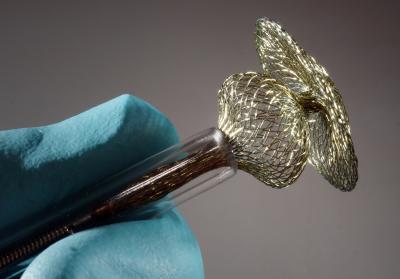Most of the public doesn't know this, but some people are allergic to metal. 10 percent of the Germany public is allergic to nickel, according to background information in a new paper.
But medical implants use nickel. Nickel-titanium alloys are increasingly used as material for cardiovascular implants in minimal invasive surgery and, once implanted, these alloys can release small amounts of nickel due to corrosion. Is that dangerous?
A team led by Jena researchers Professor Rettenmayr and Dr. Andreas Undisz report that the release of nickel from wires made of nickel-titanium alloys is very low, even over long periods of time. The testing period for metal release, as requested for governmental approval of a medical implant, is only a few days but the Jena research team monitored the release of nickel over eight months.
Examination objects were fine wires from a superelastic nickel-titanium alloy that are, for example, applied in the form of occluders (these are medical implants used for the correction of a defective cardiac septum). Such occluders often consist of two tiny wire-mesh "umbrellas", approximately the size of a 1 Euro coin. The superelastic implant can be mechanically drawn into the shape of a thin thread, which then can be placed in a cardiac catheter. "By that means the occluders can be put into place via minimal invasive surgery," Undisz says. Ideally the implant will stay in the patient's body for years or decades.

An occluder made of a nickel-titanium alloy. These medical implants are used for the correction of a defective cardiac septum. Credit: Photo: Jan-Peter Kasper/FSU
Undisz and the doctoral candidate Katharina Freiberg wanted to find out what happens during this period of time with the nickel-titanium wire. They exposed samples of the wires, which underwent different mechanical and thermal pre-treatment, to highly purified water. They then examined the release of nickel according to pre-defined time intervals.
"This wasn't trivial at all", Undisz says, "because the concentration of the released metal is often at the limit of detection." However, in co-operation with scientists from the Institute for Clinical Chemistry and Laboratory Medicine of the Jena University Hospital the materials scientists successfully developed a reliable test routine to measure the process of the nickel release.
"Mostly in the first days and weeks, depending on the pre-treatment of the material, considerable amounts of nickel may get released," Undisz summarizes the results. According to the materials scientist this is due to the mechanical strain of the implant during the surgery. "The deformation damages the thin layer of oxide covering the material. As a consequence the initial nickel release increases." In the long run, however, the nickel release decreases to amounts of a few nanograms per day and is hence far below the amount of nickel that we absorb anyway through our food on a daily basis.




Comments